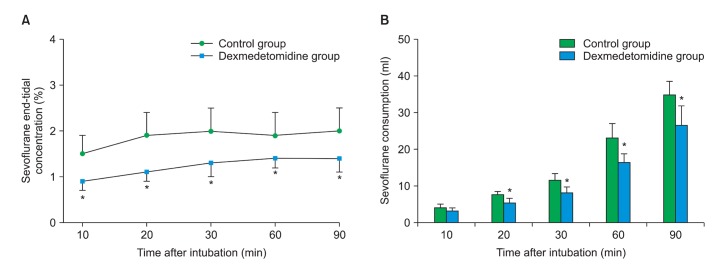1. Nishikawa K, Kubo K, Obata H, Yanagawa Y, Saito S. The influence of manipulations to alter ambient GABA concentrations on the hypnotic and immobilizing actions produced by sevoflurane, propofol, and midazolam. Neuropharmacology. 2011; 61:172–180. PMID:
21497611.

2. Bhana N, Goa KL, McClellan KJ. Dexmedetomidine. Drugs. 2000; 59:263–268. PMID:
10730549.

3. Venn RM, Hell J, Grounds RM. Respiratory effects of dexmedetomidine in the surgical patient requiring intensive care. Crit Care. 2000; 4:302–308. PMID:
11056756.
4. Patel A, Davidson M, Tran MC, Quraishi H, Schoenberg C, Sant M, et al. Dexmedetomidine infusion for analgesia and prevention of emergence agitation in children with obstructive sleep apnea syndrome undergoing tonsillectomy and adenoidectomy. Anesth Analg. 2010; 111:1004–1010. PMID:
20705788.

5. Carollo DS, Nossaman BD, Ramadhyani U. Dexmedetomidine: a review of clinical applications. Curr Opin Anaesthesiol. 2008; 21:457–461. PMID:
18660652.

6. Chrysostomou C, Schmitt CG. Dexmedetomidine: sedation, analgesia and beyond. Expert Opin Drug Metab Toxicol. 2008; 4:619–627. PMID:
18484919.

7. Hoy SM, Keating GM. Dexmedetomidine: a review of its use for sedation in mechanically ventilated patients in an intensive care setting and for procedural sedation. Drugs. 2011; 71:1481–1501. PMID:
21812509.
8. Basar H, Akpinar S, Doganci N, Buyukkocak U, Kaymak C, Sert O. The effects of preanesthetic, single-dose dexmedetomidine on induction, hemodynamic, and cardiovascular parameters. J Clin Anesth. 2008; 20:431–436. PMID:
18929283.

9. Kang WS, Kim SY, Son JH, Kim JD, Muhammad HB, Kim SH, et al. The effect of dexmedetomidine on the adjuvant propofol requirement and intraoperative hemodynamics during remifentanil-based anesthesia. Korean J Anesthesiol. 2012; 62:113–118. PMID:
22379564.

10. Aldrete JA. The post-anesthesia recovery score revisited. J Clin Anesth. 1995; 7:89–91. PMID:
7772368.

11. Murthy TVSP, Singh R. Alpha 2 adrenoreceptor agonist-dexmedetomidine role in anaesthesia and intensive care: a clinical review. J Anaesth Clin Pharmacol. 2009; 25:267–272.
12. Arcangeli A, D'Alò C, Gaspari R. Dexmedetomidine use in general anaesthesia. Curr Drug Targets. 2009; 10:687–695. PMID:
19702517.

13. Ebert TJ, Hall JE, Barney JA, Uhrich TD, Colinco MD. The effects of increasing plasma concentrations of dexmedetomidine in humans. Anesthesiology. 2000; 93:382–394. PMID:
10910487.

14. Tufanogullari B, White PF, Peixoto MP, Kianpour D, Lacour T, Griffin J, et al. Dexmedetomidine infusion during laparoscopic bariatric surgery: the effect on recovery outcome variables. Anesth Analg. 2008; 106:1741–1748. PMID:
18499604.

15. Wijeysundera DN, Naik JS, Beattie WS. Alpha-2 adrenergic agonists to prevent perioperative cardiovascular complications: a meta-analysis. Am J Med. 2003; 114:742–752. PMID:
12829201.

16. But AK, Ozgul U, Erdil F, Gulhas N, Toprak HI, Durmus M, et al. The effects of pre-operative dexmedetomidine infusion on hemodynamics in patients with pulmonary hypertension undergoing mitral valve replacement surgery. Acta Anaesthesiol Scand. 2006; 50:1207–1212. PMID:
16978159.

17. Aantaa R. Assessment of the sedative effects of dexmedetomidine, an alpha 2-adrenorecptor agonist with analysis of saccadic eye movements. Pharmacol Toxicol. 1991; 68:394–398. PMID:
1682907.
18. Kulkarni A, Price G, Saxena M, Skowronski G. Difficult extubation: calming the sympathetic strom. Anaesth Intensive Care. 2004; 32:413–416. PMID:
15264740.
19. Ingersoll-Weng E, Manecke GR Jr, Thistlethwaite PA. Dexmedetomdine and cardiac arrest. Anesthesiology. 2004; 100:738–739. PMID:
15108994.
20. Elliott P, O’Hare R, Bill KM, Phillips AS, Gibson FM, Mirakhur RK. Severe cardiovascular depression with remifentanil. Anesth Analg. 2000; 91:58–61. PMID:
10866887.

21. Hall JE, Uhrich TD, Barney JA, Arain SR, Ebert TJ. Sedatives, amnestic, and analgesic properties of small-dose dexmedetomidine infusions. Anesth Analg. 2000; 90:699–705. PMID:
10702460.
22. Snapir A, Posti J, Kentala E, Koskenvuo I, Sundell I, Tuunanen H, et al. Effects of low and high plasma concentrations of dexmedetomidine on myocardial perfusion and cardiac function in healthy male subjects. Anesthesiology. 2006; 105:902–910. PMID:
17065883.

23. Khan ZP, Munday IT, Jones RM, Thornton C, Mant TG, Amin D. Effect of dexmedetodmine on isoflurane requirements in healthy volunteers. I: Pharmacodynamic and pharmacokinetic interactions. Br J Anaesth. 1999; 83:372–380. PMID:
10655905.
24. Isik B, Arslan M, Tunga AD, Kurtipek O. Dexmedetomidine decreases emergence agitation in pediatric patients after sevoflurane anesthesia without surgery. Paediatr Anaesth. 2006; 16:748–753. PMID:
16879517.

25. Venn RM, Karol MD, Grounds RM. Pharmacokinetics of dexmedetomidine infusions for sedation of postoperative patients requiring intensive care. Br J Anaesth. 2002; 88:669–675. PMID:
12067004.
26. Iirola T, Ihmsen H, Laitio R, Kentala E, Aantaa R, Kurvinen JP, et al. Population pharmacokinetics of dexmedetomidine during long-term sedation in intensive care patients. Br J Anaesth. 2012; 108:460–468. PMID:
22277665.

27. Gurbet A, Basagan-Mogol E, Turker G, Ugun F, Kaya FN, Ozcan B. Intraoperative infusion of dexmedetomdine reduces perioperative analgesic requirements. Can J Anaesth. 2006; 53:646–652. PMID:
16803911.
28. Feld JM, Hoffman WE, Stechert MM, Hoffman IW, Ananda RC. Fentanyl of dexmedetomidine combined with desflurane for bariatric surgery. J Clin Anesth. 2006; 18:24–28. PMID:
16517328.
29. McQueen-Shadfar LA, Megalla SA, White WD, Olufolabi AJ, Jones CA, Habib AS. Impact of intraoperative dexmedetomidine on postoperative analgesia following gynecologic surgery. Curr Med Res Opin. 2011; 27:2091–2097. PMID:
21916531.

30. Lawrence CJ, De Lange S. Effects of a single pre-operative dexmedetomidine dose on isoflurane requirements and peri-operative haemodynamic stability. Anaesthesia. 1997; 52:736–744. PMID:
9291757.


